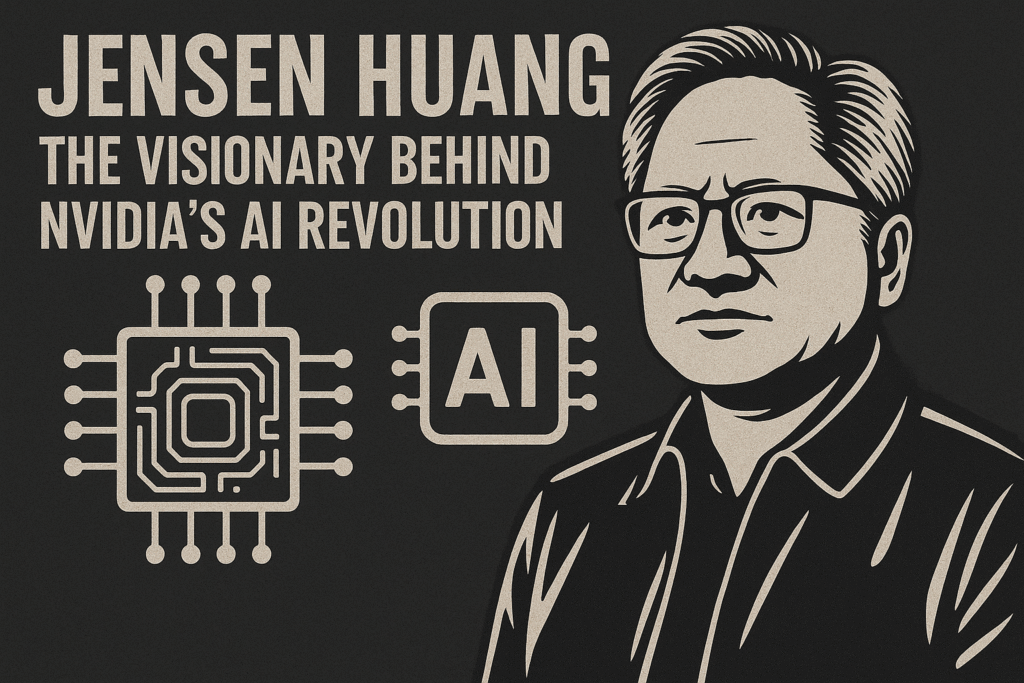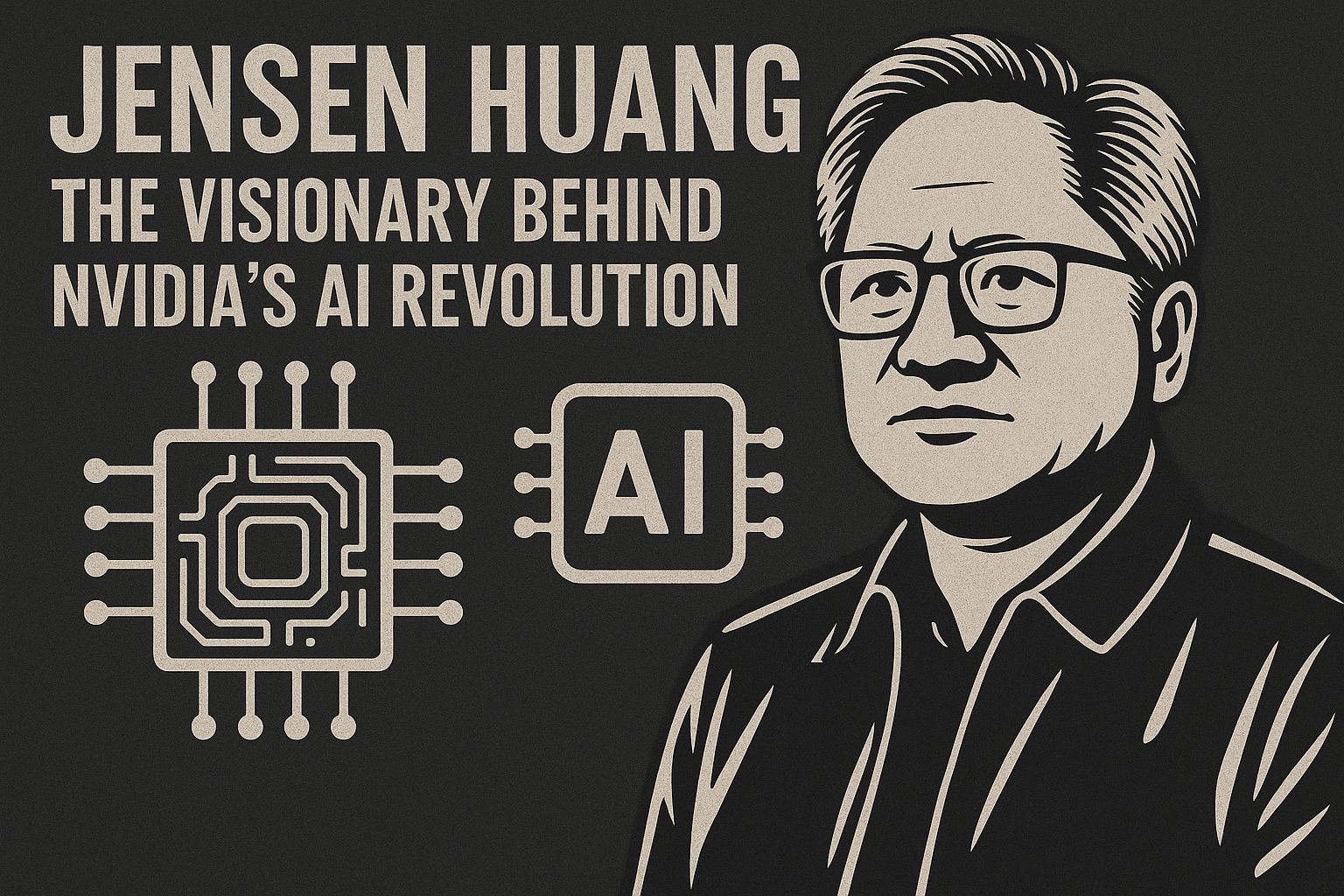Jensen Huang, the co-founder, president, and CEO of Nvidia, has emerged as one of the most influential figures in the technology world, steering his company to the forefront of the artificial intelligence (AI) revolution.
Born on February 17, 1963, in Taipei, Taiwan, Huang’s journey from humble beginnings to leading the world’s largest semiconductor company is a testament to his resilience, foresight, and relentless drive.
As of July 2025, Nvidia’s market capitalization has soared past $4 trillion, and Huang’s net worth is estimated at $144 billion, making him one of the wealthiest individuals globally. This article explores Huang’s life, his pivotal role in Nvidia’s success, and his broader impact on the tech industry and society.
Early Life and Unlikely Beginnings
Jensen Huang’s story begins with a childhood marked by displacement and adaptation. The son of Taiwanese immigrants, Huang spent his early years in Taiwan and Thailand.
At age nine, amidst social unrest in Thailand, his parents sent him and his brother to the United States, where they lived with an uncle in Tacoma, Washington.
In a twist of fate, his aunt and uncle mistakenly enrolled him in Oneida Baptist Institute in Kentucky, a religious reform school for troubled youth, believing it to be a prestigious boarding school. To afford the tuition, Huang’s parents sold nearly all their possessions.
Living in the boys’ dormitory, young Jensen navigated a challenging environment, learning resilience and independence early on.
Huang’s adaptability shone through as he worked as a waiter at Denny’s, a job that helped him overcome his shyness and hone his interpersonal skills.
His academic journey took him to Oregon State University, where he earned a Bachelor of Science in Electrical Engineering, followed by a Master’s degree from Stanford University. These formative experiences laid the groundwork for his future success, blending grit with technical expertise.

Founding Nvidia: A Bold Bet on GPUs
In 1993, at the age of 30, Huang co-founded Nvidia with Chris Malachowsky and Curtis Priem at a Denny’s restaurant in San Jose, California. The trio started with a modest $600 in capital—$200 from each founder—and a vision to revolutionize computer graphics.
Huang, the youngest of the group, was appointed president and CEO on day one, a decision his co-founders supported despite his relative inexperience. Securing initial funding from LSI Logic’s CEO Wilfred Corrigan and venture capitalist Don Valentine of Sequoia Capital, Nvidia began developing its first graphics processing unit (GPU).
Huang’s early leadership was defined by bold, risky bets. In the late 1990s, Nvidia faced near-bankruptcy, but Huang’s decision to shift from serial to parallel processing architecture transformed the company’s trajectory.
This “radical gamble,” as described by author Stephen Witt, made Nvidia’s GPUs indispensable for gaming and, later, AI applications. Huang’s ability to foresee the potential of parallel computing, coupled with the development of CUDA (Compute Unified Device Architecture), positioned Nvidia as a leader in high-performance computing.
The AI Boom and Nvidia’s Ascendancy
Nvidia’s meteoric rise in the 2020s is largely attributed to the AI boom, with Huang at the helm navigating the company into uncharted territory. Originally designed for gaming, Nvidia’s GPUs became the backbone of AI training, powering large language models (LLMs) and other compute-intensive applications.
By May 2023, Nvidia’s market value surged by $200 billion in a single day after reports confirmed that ChatGPT was trained on its supercomputers. Today, Nvidia is the world’s most valuable chipmaker, surpassing tech giants like Apple and Microsoft.
Huang’s strategic foresight has been instrumental. He recognized early that AI would require immense computational power, and Nvidia’s GPUs were uniquely suited for the task.
His philosophy of “tools over grand visions” emphasizes building the fastest, most efficient chips possible, a mindset that has driven Nvidia’s dominance in the AI infrastructure market. As one Wall Street analyst noted, “There’s a war going on out there in A.I., and Nvidia is the only arms dealer.”
Leadership Style and Controversies
Huang’s leadership is a study in contradictions: inspiring yet demanding, visionary yet pragmatic. Known for his intense work ethic, he sends hundreds of concise emails daily—described by subordinates as “haiku” or “ransom notes”—and personally reviews employees’ weekly priorities.
His temper, dubbed the “Wrath of Huang,” is legendary, yet he inspires fierce loyalty among his team. One executive remarked, “I’ve been afraid of Jensen sometimes. But I also know that he loves me.”
Huang’s stance on AI’s societal impact has sparked debate. In a July 2025 CNN interview with Fareed Zakaria, he acknowledged AI’s potential to disrupt jobs, stating, “If the world runs out of ideas, then productivity gains translate to job loss.”
However, he argued that innovation could create new opportunities, citing historical technological advancements that boosted both employment and productivity. Critics, including Anthropic’s Dario Amodei, warn of AI-induced unemployment, but Huang remains optimistic, viewing AI as a “technology equalizer” accessible to all.
Geopolitically, Huang has navigated complex waters. In April 2025, he met with Chinese trade officials in Beijing amid U.S. export controls on Nvidia’s H20 AI chips. Huang called these restrictions a “failure,” arguing that they accelerate China’s tech independence without curbing its military capabilities.
Critics, like trade analyst Dewardric McNeal, counter that Huang’s focus on market access overlooks national security concerns, pointing to China’s “Made in China 2025” strategy as evidence of its long-term goals.
Philanthropy and Legacy
Beyond business, Huang is a committed philanthropist. He donated $30 million to Stanford University for an engineering center and $50 million to Oregon State University for a research center named in his honor.
His journey from a Taiwanese immigrant to a tech titan has made him a cultural icon, particularly in Taiwan, where his celebrity status has been dubbed “Jensanity,” drawing comparisons to the “Linsanity” phenomenon.
Looking Ahead
As Nvidia continues to shape the AI landscape, Huang’s vision remains focused on innovation and accessibility. His recent comments at Computex 2025 and the Hong Kong University of Science and Technology highlight his belief in AI’s transformative potential, from robotics to autonomous vehicles.
Yet, challenges loom, including export restrictions, competition from rivals like Huawei, and the need to sustain Nvidia’s growth in a volatile market.
Jensen Huang’s legacy is one of bold bets and relentless execution. From a Denny’s booth to the pinnacle of the tech world, he has redefined what’s possible, turning Nvidia into the engine of the AI revolution.
As he navigates the opportunities and risks ahead, Huang’s story underscores the power of vision, adaptability, and an unyielding commitment to progress.
